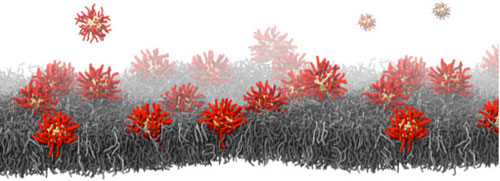| Apr 23, 2019 | |
Scientists explore the unknown behaviour of gold nanoparticles with neutrons(Nanowerk News) Nanoparticles of less than 100 nanometres in size are used to engineer new materials and nanotechnologies across a variety of sectors. Their small size means these particles have a very high surface area to volume ratio and their properties depend strongly on their size, shape and bound molecules. This offers engineers greater flexibility when designing materials that can be used in our everyday lives. |
|
| Nanoparticles are found in sun creams and cosmetics as well as inside our bodies, as drug delivery vehicles and as contrast agents for pharmaceuticals. Gold nanoparticles are proving to be a next-generation tool in nanoengineering as an effective catalyst at such small dimensions. | |
| However, nanomaterials also pose a potential risk, as their interactions with living matter and the environment are not fully understood, meaning that they might not perform as expected, for instance in the human body. | |
| While scientists have been able to fine-tune and engineer the properties of nanoparticles by changing their size, shape, surface chemistry and even physical state, such a variety of possibilities means that dictating precisely how the particles behave at that small scale also becomes extremely difficult. This is of particular concern as we rely on the potential use of nanoparticles within the human body. | |
| Gold nanoparticles are good carriers of large and small molecules, making them ideal for transporting drugs to human cells. However, predicting how far they are then absorbed by the cells, their toxicity, is difficult. As is understanding any associated risks to health using these nanomaterials. | |
| A European collaboration of researchers, including scientists from the Institut Laue-Langevin, Tampere University, University of Helsinki, Norwegian University of Science and Technology, and Université Grenoble Alpes, investigated the physical and chemical influences when gold nanoparticles interact with a model biological membrane, in order to identify the behavioural mechanisms taking place. | |
 |
|
| Researchers investigate new interactions between gold nanoparticles and cell membranes. (Image: ILL) | |
| Better understanding the factors that determine whether nanoparticles are attracted or repelled by the cell membrane, whether they are adsorbed or internalised, or whether they cause membrane destabilisation, will help us to ensure that nanoparticles interact with our cells in a controlled way. This is particularly important when using gold nanoparticles for drug delivery for example. | |
| As outlined in the journal Small ("The role of temperature and lipid charge on intake/uptake of cationic gold nanoparticles into lipid bilayers"), the researchers used a combination of neutron scattering techniques and computational methods to study the interaction between positively charged cationic gold nanoparticles and model lipid membranes. | |
| The study showed how the temperature and the lipid charge modulate the presence of energy barriers that affect the interaction of the nanoparticle with the membrane. Furthermore, different molecular mechanisms for nanoparticle-membrane interactions are revealed which explain how nanoparticles become internalised in the lipid membranes, and how they cooperatively act to destabilise a negatively charged lipid membrane. | |
| Using Molecular Dynamics (MD) – a computational simulation method for studying the movement of atoms – the researchers demonstrated how gold nanoparticles interacted within the system at the atomic level. This gives a complementary tool to interpret and explain the data obtained on real systems by neutron reflectometry. This study shows convincingly that the combination of neutron scattering and computational methods provides a better understanding than just one of the methods alone. | |
| Giovanna Fragneto, Head of Soft Matter Science and Support at ILL said: “Nanoparticles are proving to be an invaluable tool to help us address a number of social challenges. For instance, as well as mechanisms for drug delivery, gold particles can prove useful for cancer imaging. With so much promise for the future, it is important that we develop the tools to better investigate nanomaterials, so we can harness them effectively and safely. This is made possible through developments in neutron science techniques and advances in sample environment and sample preparation, performed at facilities such as ILL.” | |
| Marco Maccarini, research scientist at the Université Grenoble Alpes, said: “There are thousands of different nanoparticles of different sizes and compositions, which all impact on cells differently. The complementarity of computational and neutron techniques highlighted in this study has helped to provide a clearer indication of what influences the behaviour of nanoparticles. This will help us predict how cells will interact with nanoparticles in future.” |
| Source: Institut Laue-Langevin | |
|
Subscribe to a free copy of one of our daily Nanowerk Newsletter Email Digests with a compilation of all of the day's news. |
